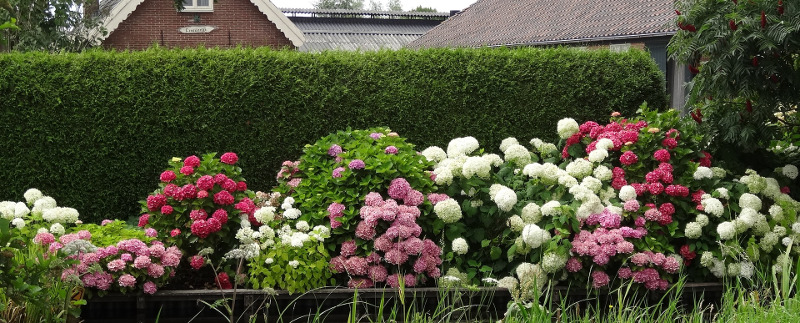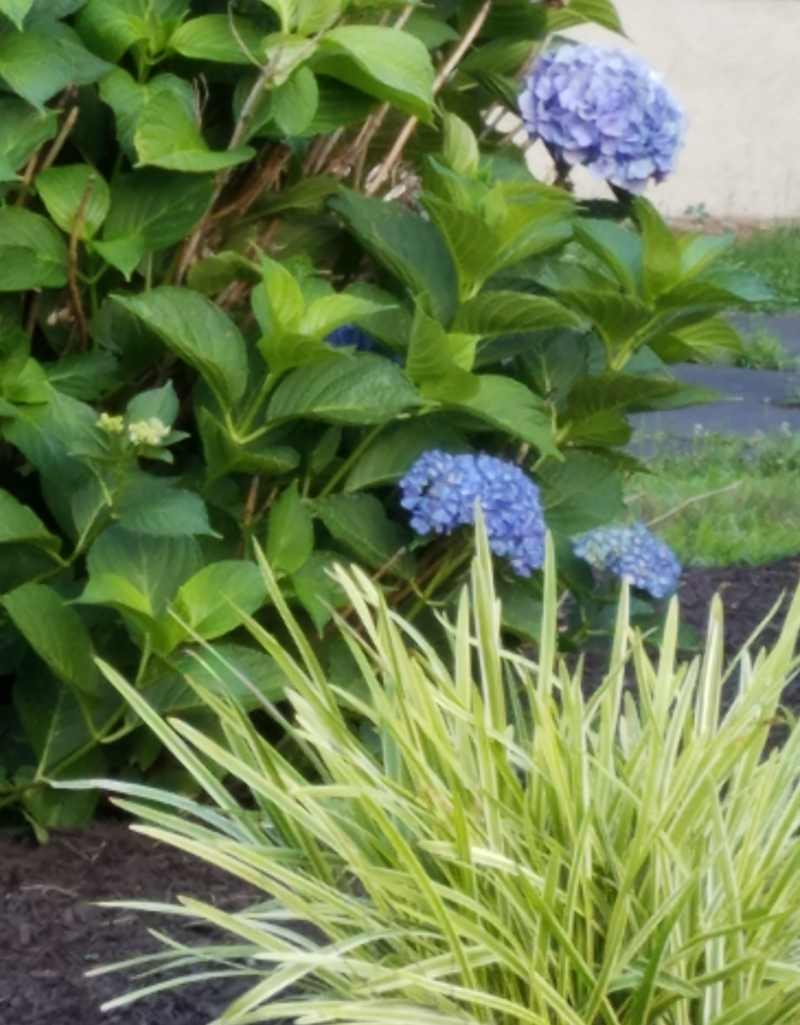Author Maureen Farmer - Last Updated 8-5-2021
Hydrangeas are very popular shrubs that most gardeners love growing for their huge colorful flowers.
Hydrangeas require well drained soil that is nutrient rich and lots of moisture. We always recommend adding a layer of mulch around hydrangeas to help retain that moisture and add more nutrients back into the ground. Some hydrangeas also require a little protection in the winter in order to bloom the following year. These requirements are things that you should look for when determining what to plant with your hydrangeas. Or where in your garden you should add hydrangeas to, with the plants that you already have growing.
Many gardeners grow hydrangeas in groups to create borders in their gardens or as foundation plants. Did you know that mixing hydrangeas can make great additions to perennial borders or island gardens?
There are many plants that compliment hydrangeas thankfully. Here are a few ideas for companion plants for hydrangeas including perennials, shrubs and annuals. There is also an exhaustive list at the very bottom of the article. We also listed which plants that do not do well growing next to hydrangeas at the bottom.

Shrubs To Plant With Hydrangeas
Azaleas, hollies, yews, mahonia, gardenia, loropetalum and boxwood shrubs will look good planted in front of hydrangeas. Azaleas blossoms will provide early color. You can select your favorite blossom color since the azalea blooms will have faded before your hydrangea is flowering.
Boxwoods and evergreen varieties of azaleas will offer some color during the winter months. Boxwoods can be shaped or left in their natural form based on your preference for a more formal or natural-looking garden. These can also help provide some protection against strong winds in the winter.
Perennials To Plant With Hydrangeas
Shade tolerant perennials make excellent partners next to hydrangeas. Some of the best are hostas, ferns, foxglove & coral bells.
Many upright hydrangeas create a shady area under their foliage. This is a great location for planting shade-loving hostas. Most gardeners grow hostas for their lovely foliage. The hydrangea leaves above will hide the pale hosta flower spikes that some gardeners remove because they find them unattractive.
Hostas are available in several shades of green ranging from blue-green to chartreuse. Many have solid colored leaves and others have white or yellow variegations running along their length. Select foliage that will compliment your hydrangea blossoms.
You can use all the same variety or a mixture of two or three varieties. Plant them in a single row in a circle or half-circle around the hydrangea base or in small groups in a triangular pattern. Pink hydrangea blossoms partner well with hostas with bluish leaves and white blooms work well with green and white variegated hosta varieties.
Hostas are also available in different heights and leaf widths. They tend to grow larger every year, so space them as directed on the label even if they seem relatively far apart at first. If you don’t like the gaps, plant annuals to fill the open spots during the first year or two.
If you choose perennials that need more sun, like daylilies, then plant those next to hydrangeas that can tolerate more sun like smooth or panicle hydrangeas.
Annuals To Plant With Hydrangeas
As with perennials, shade tolerant annuals grow great next to hydrangeas. These plants also typically prefer having rich and fertile soil and being watered frequently. Some of the best annuals to grow with hydrangeas are coleus, impatiens and begonias.
Brighten up the shady base of your hydrangeas with annual flowers and foliage plants. The nice thing about adding annuals is that you can mix it up and try different plant combinations or flower colors every year.
Good shade-tolerant options include begonias, coleus, browallia, euphoria and impatiens. These plants are available in varieties with multiple options for blossom color and in some cases different foliage colors.

Trees To Plant With Hydrangeas
Consider planting next to medium sized trees to help protect against the afternoon sunlight. Dogwoods, crape myrtles & dwarf Japanese maples are typically great next to hydrangeas. Dwarf Japanese maples with dark foliage for contrast with green hydrangea leaves. Japanese maples typically have smaller and airier leaves than hydrangea to also provide leaf texture contrast.
Ornamental Grasses To Plant With Hydrangeas
Low maintenance ornamental grasses will be a good partner in sunnier locations. Short grasses can be used in front along the border of a hydrangea bed and taller ones can be used at the ends of a hydrangea border garden. Their texture will be a nice compliment to the larger leaves of most hydrangeas. They’ll also add movement to your garden on breezy days.

Best Hydrangea Companion Plants For Containers
Hydrangeas make perfect container plants. It allows you to get beautiful colorful flowers in new locations like patios, decks, entryways and underneath large trees with big root systems. Just be sure to leave enough space for the hydrangea roots and the plants you grow with the hydrangea in the container. Look at the mature size of the hydrangea to determine how large of a container you will need. In the winter, the hydrangea may need to have additional protection in colder climates as well.
Some of our favorite plants to grow in planters with hydrangeas are ferns, sweet potato vines, variegated English ivy, kalanchoe, ornamental oregano, caladium, coral bells and coleus.
Plants Not to Grow With Hydrangeas
Hydrangeas can grow well with most plants. However, do not plant hydrangeas in locations where they will receive no sunlight at all. This will drastically reduce the amount of flowers the plants will produce. So tall trees and shrubs planted close by can be helpful in the afternoon heat, but not if they eliminate all sunlight hitting the plants.
